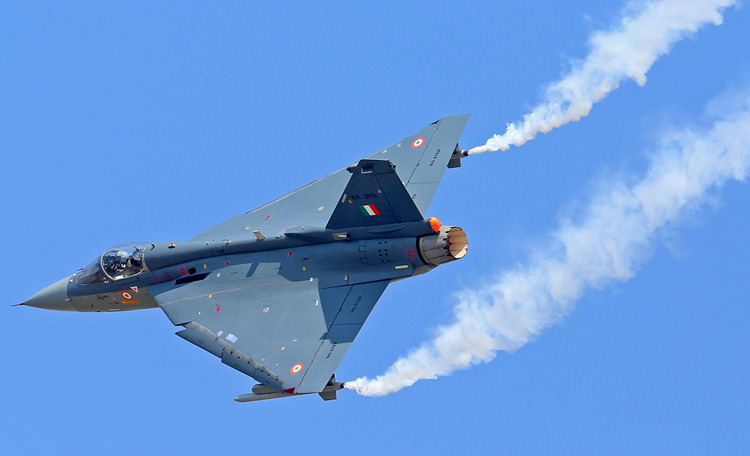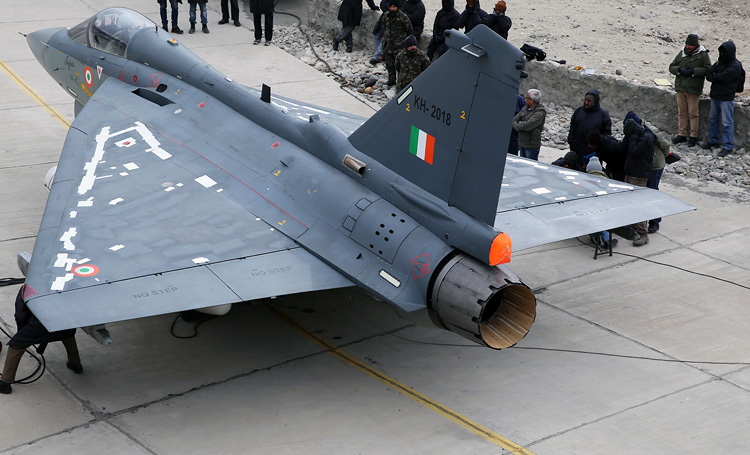INDIAN ARMED FORCES CHIEFS ON
OUR RELENTLESS AND FOCUSED PUBLISHING EFFORTS

SP Guide Publications puts forth a well compiled articulation of issues, pursuits and accomplishments of the Indian Army, over the years

I am confident that SP Guide Publications would continue to inform, inspire and influence.

My compliments to SP Guide Publications for informative and credible reportage on contemporary aerospace issues over the past six decades.
- Prime Minister witnesses 'Bharat Shakti' – a Tri-Services Firing and Manoeuvre Exercise in Pokhran, Rajasthan
- Interim Defence Budget 2024-25 — An Analysis
- Union Defence budget 2024
- Prime Minister Modi Commemorates Indian Navy Day in a Grand Ceremony
- Prime Minister Modi Flies in the LCA Tejas
- New Chapter in India-Italy Defence Ties
- Airpower beyond Boundaries
HAL shedding 10 per cent stakes – Token move?
 |
By Lt. General P.C. Katoch (Retd) Former Director General of Information Systems, Indian Army |

The government has recently approved the sale of 10 per cent stake in Hindustan Aeronautics Limited (HAL), a Defence Public Sector Undertaking (DPSU). Suvarna Raju, CMD of HAL has termed it a “major milestone”. On September 29, HAL had initiated the process of initial public offering with the filing of the Draft Red Herrring Prospectus (DRHP) with market regulator Securities and Exchange Board of India. The announcement was delayed as HAL required concessions on putting out all data in public domain; HAL had reported profit before taxation of 3,294 crore on revenue of 17,406 cr for fiscal ending March 2017. Now HAL with its IPO is likely to offload some 3,615 cr equity share value of 10 each representing 10 per cent of its paid up equity capital. According to RK Tyagi, former Chairman HAL, 10 per cent disinvestment means the control remains with the Government and when HAL gets quoted on stock market the corporate governance and accountability measures are better; the company has to file reports every quarter meaning budgets, balance sheet will be made. HAL is manufacturing Tejas fighter jets, Sukhoi-30 MKI fighter jets under licensed production, in-house designed helicopters and trainer jet Hawk. HAL is not in the race to build the 200 single-engine fighter jets that the Indian Air Force is seeking to induct.
The Tejas frankly is only part indigenous with around 85 per cent parts and assemblies imported. Purely in strategic terms, the absence of indigenous combat aircraft in the IAF should be the foremost concern to the policy makers in India. This must be given even more importance in the face of a rising China and its array of weapon systems in the air, backed by an exhaustive production line of indigenous fighters; China’s overwhelming superiority in the number of indigenous combat aircraft may lead to a potential conflict situation, perhaps even without a conflagration on ground. Foreign analysts note that the LCA Tejas has been handicapped by technological challenges, cost overruns and delays over a decade since the program began in 1983; induction of Tejas into IAF in January 2015 took 32 years after the program began. However, it must be acknowledged that India, being novice in aircraft manufacturing, started from a scratch. Therefore, the time period of 32 years for induction into the IAF is not bad. But what is material here is where does the current model of Tejas stand in the current and future environment of conflict with China and Pakistan. To say that we are ready to fight a two-front war is technically correct because we will simply would have no choice if war is thrust upon us - the difference being that we will fight with what we have. But these are more political statements. The logic that technologically superior aircraft, like the Rafale, can compensate for numbers is hardly justified when looking a dual-front war considering sheer numbers and with the cyber, space and electromagnetic domains fully activated. The IAF's fighter strength has already slumped to 33 squadrons against 45 squadrons, whereas we should be aiming for 50-squadron strength by 2025-2030.

The whole process of defence production in India, HAL included, needs to be reconfigured and double-kick-started. When the present government came to power, there was much noise about privatization and disinvestment. The arguments against 'total' privatization are: loss of complete government control, possible leak of information to rival nations and illegal supplies (which is a possibility otherwise too); dangers of sharing of information like source design and code with the inimical countries; entry of foreign players through FDI will suppress the indigenous arms producing industries (why would that be if the foreign firm partnering an India company in joint venture (JV), and; inability of defence PSU’s to face competition posed by foreign companies (that is why private industry must be fully integrated rather than relying on defence PSU's). But privatization apart, the disinvestment like 10 per cent stakes in HAL, is obviously too little and even too late considering the requirements. True, the Cabinet was 'considering' last year to sell 26 per cent shares of the DPSU Bharat Earth Movers Limited (BEML) to the private sector (government presently owns 54 per cent of total equity of BEML and rest 46 per cent is held by public, financial Institutions, foreign institutional investors, banks, and employees), as also disinvestment in some 10 other DPSUs but not much has happened on ground due to the defence bureaucracy, backed up by the unions of the DPSUs. the fact remains that as long as the private sector is discriminated against (which continues unabated behind the screen), and not provided level playing field, in favour of DPSUs by the Department of Defence Production (DoDP), defence indigenization will take decades to attain required levels. in fact, there is strong case for the DRDO and DPSU's to be placed directly under the Ministry of Heavy Industries, which alsone can break the undesirable nexus of the defence bureaucracy. The actual capabilities of the Tejas Mk 1 compared to what IAF wants is a closely guarded secret but obviously there is mismatch because of which, going by one report, the IAF want to place an order for only 88 x Tejas Mk 1 and go for balance requirement with Tejas Mk 2 version (when HAL can field the Mk 2 is unknown).
The IAF seeking improvements in Mk 1 Tejas include improveved performance, interchangeability, address all issues of looms, improved engine, improved avionics and fitment of missiles - all this will require major design changes. The aviation sector is set to take off with various indian industry giants tying up JVs with foreign partners under the Strategic Partnership Model (SPM). The Reliance Group has recently announced that the indigenous Falcon will fly in 2022, but the requirement of an indigenous fighter jet must get due precedence. In this context, what is not talked about but has been openly expressed by Boeing must be taken serious note of: successful examples of transfer of technology (ToT) based manufacture involves co-opting of public enterprises and private enterprises in a way that leveraged the investment made in the public enterprise for multiple decades; highly experienced DPSUs like HAL need to be similarly co-opted, since that is where aerospace expertise and experience lies in India; the SPM requires major reorientation - private firms chosen as SP's to enter technology partnerships with nominated global original equipment (OEM) manufacturers bidding jointly for contracts to build aircraft, helicopters, submarines armoured vehicles etc like it happens abroad (including in Japan and many other countries), competing with the DRDO and DPSUs. The government needs to seriously look at greater disinvestment of HAL while retaining overall control, incoprporating indigenous private indiustry rather than establishing new JVs for aircrafts and helicopters where no experience and expertise exists on the Indian side.





